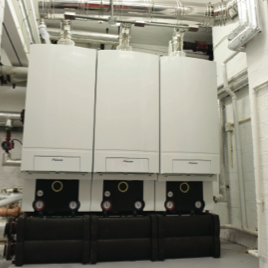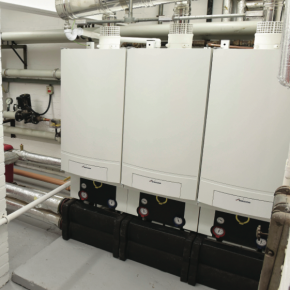
Getting the right heating mix: delivering reliability to schools
Ever-increasing pressure on the budgets of schools around the country means optimised energy performance is key to maximising the funds available for educational resources, rather than the running costs of the building. Pete Mills, commercial technical operations manager at Bosch Commercial and Industrial, explains some of the most important considerations to make when it comes to heating and hot water, and which technologies are best suited to delivering reliability and energy efficiency, in the latest issue of ABC&D magazine.
Finding the funds for repair or replacement can be a daunting challenge for schools suddenly faced with a heating system breakdown, so when it does come to deciding on an alternative system, energy efficiency and ROI should be top of the agenda to ensure any money saved can be spent elsewhere on site.

“A wall-hung condensing boiler offers accessibility, speed and flexibility of installation” Pete Mills, Bosch Commercial and Industrial
Even though many older systems operate at temperatures of 82°C flow and 71°C return, condensing boilers can be made to work efficiently for educational buildings through the use of weather compensation and effective control. Consideration can also be given to the possibility of rebalancing the system to 80°C flow and 60°C return for further savings. With energy efficiency a top priority, schools should be turning to boilers which can automatically modulate their output down to as little as 20% in order to precisely match the demand for heat, helping to reduce fuel consumption and improve overall seasonal efficiency. This is useful for periods like the summer holidays where there may only be limited demand for heating and hot water. For schools planning development to include further facilities, a cascade system can also help to future proof, to cater for increased heating demand.
Ageing schools and their challenges
With some of the UK’s school buildings dating back to the sixth century, it’s no wonder that some of these buildings are struggling to cope with the use demanded of them. Heritage school buildings, despite their beauty, come at a cost and present certain challenges when trying to incorporate modern energy efficient technologies. Their ageing infrastructure means installers are often welcomed with narrow plant rooms and have old pipework to contend with when trying to install new boilers. However, concerns with mixing the old with the new shouldn’t stop schools from replacing their heating system with a more efficient alternative. Fortunately, the modern condensing boiler is a good fit despite these restrictions.
Some boilers, for example, have compact dimensions when cascaded in systems up to 800kW, which make them especially suitable for plant rooms which are difficult to access and restricted in space. This, in turn, reduces installation time so there is minimal disruption to staff and pupils.
Integrating new boilers with pre-existing pipework can affect the operation and efficiency of any new heating appliances, but this can be easily avoided with the addition of a plate heat exchanger. This provides two elements of protection by separating old and new systems allowing them to work efficiently together.
Coping with fluctuating demand
With schools usually closed for around 12 weeks of the year, it can be difficult for their managers to ensure they have a heating system in place that caters for this fluctuating demand for hot water. For example, showers for PE lessons and after-school sport, along with the wash-down of kitchen equipment, plates and cutlery after lunch, can cause dramatic peaks in the amount of hot water required. This rise and fall in demand can take its toll on older heating systems, which can struggle to cope and send costs through the roof.
A continuous flow hot water system is suitable for coping with these peaks in demand, providing instantaneous hot water at a set temperature to ensure regulations are adhered to and only using energy when hot water is required, thus maximising efficiency. Providing heating and hot water via two separate systems will ensure that any peaks in demand for hot water can be easily catered for.
This continuous supply of hot water is suitable for schools with cafeterias, bathrooms and changing rooms with showers that can all demand hot water at the same time. What’s more, the instantaneous water heating technology frees the need for a storage cylinder, which saves space, reduces energy loss and lowers the risk of Legionella constamination. The condensing technology also allows for greater energy efficiency of upto 150%, resulting in significant energy savings.
The water heaters can be installed as single units or in a cascade of up to 12 units to provide a combined flow rate of up to 247L/min. This makes it suitable for schools which can have surges in demand for domstic hot water depending on the occupancy of the building.
With energy saving a major objective for schools and pressure on budgets increasing, condensing boilers and a continuous flow hot water system could be the ultimate partnership to ensure a school can cater to demand, enhance its energy efficiency credentials and, ultimately, stay open while improving the learning environment for students and staff.
Latest news

21st February 2025
ASSA ABLOY EMEIA: Save valuable time and money with a seamless switch to programmable digital keys
In 2025, access management can be a whole lot easier. By making access part of their digital processes, businesses can put time-consuming key management and the cost of changing the locks firmly behind them. Making this switch is a lot easier than many people think, as ASSA ABLOY explains here…
Posted in Access Control & Door Entry Systems, Architectural Ironmongery, Articles, Building Industry News, Building Products & Structures, Building Services, Doors, Facility Management & Building Services, Health & Safety, Information Technology, Innovations & New Products, Retrofit & Renovation, Security and Fire Protection
21st February 2025
Showersave supports industry leaders in addressing Part L and Part G regulations
Showersave has sponsored and participated in a recent Building Insights LIVE roundtable on ‘Water & Energy Saving Innovations in New Build Housing’.
Posted in Articles, Bathrooms & Toilets, Bathrooms, Bedrooms & Washrooms, Building Associations & Institutes, Building Industry Events, Building Industry News, Building Products & Structures, Building Regulations & Accreditations, Building Services, Exhibitions and Conferences, Interiors, Pipes & Fittings, Plumbing, Retrofit & Renovation, Sustainability & Energy Efficiency
21st February 2025
GEZE: The importance of Specifying High Quality Door Closers on Fire Doors
Andy Howland, Sales & Marketing Director at GEZE UK, discusses why specifying high quality door closers on fire doors is important…
Posted in Access Control & Door Entry Systems, Accessibility, Architectural Ironmongery, Articles, Building Industry News, Building Products & Structures, Building Regulations & Accreditations, Building Services, Doors, Facility Management & Building Services, Health & Safety, Posts, Restoration & Refurbishment, Retrofit & Renovation, Security and Fire Protection
21st February 2025
Insight Data achieves ISO9001 recertification with zero non-conformities
Leading industry data specialist, Insight Data, has successfully achieved the prestigious recertification for ISO9001 with zero non-conformities for the fourth consecutive year.
Posted in Articles, Building Industry News, Building Regulations & Accreditations, Building Services, Information Technology, Research & Materials Testing
 Sign up:
Sign up: